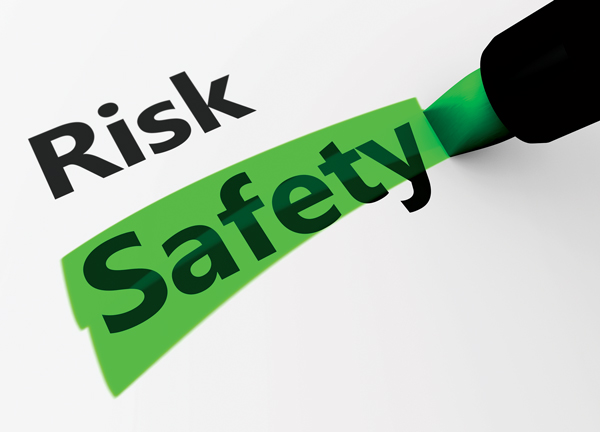BY MADELEINE MACCAR
 One of the most prevailing and persistent silver linings to emerge from the perennial storm cloud of TNCs is that their unwelcome disruption has launched both duty of care and risk management—two areas in which luxury ground transportation thoroughly trounces its shadier, cheaper counterparts—to the forefront of comparative discussions regarding the two travel options.
One of the most prevailing and persistent silver linings to emerge from the perennial storm cloud of TNCs is that their unwelcome disruption has launched both duty of care and risk management—two areas in which luxury ground transportation thoroughly trounces its shadier, cheaper counterparts—to the forefront of comparative discussions regarding the two travel options.
But to benefit from the business of those looking for a higher-touch service, you have to go well beyond differentiating yourself from TNCs: To justify your cost you need to prove that you not only deliver the safety you promise but also have a worst-case-scenario plan in place. Sure, it’s unlikely that terrorist attacks, kidnappings, and security incidents will come to fruition on your or your affiliates’ watch—but what if they do?
Abiding by the latter half of the adage “hope for the best but prepare for the worst” is a good starting place, but you have to decide what that means for your company. Revisiting, revising, and updating your duty of care standards and your risk management procedures is critical, especially as Mother Nature’s recent catastrophic hurricanes and earthquakes serve as bleak reminders that natural disasters are just as much of a threat to your well-oiled machine as inevitable human errors and ill intentions are, too. Your passengers are traveling all over the globe to places that have traditionally been risky, but also to locales that have been targets of small-scale terrorism (France, U.K., etc.) or kidnappings (especially in South America). In 2017, you can’t afford to be insular or oblivious to the country and world around you.
It is in your best interest to get ahead of the unexpected before the unexpected gets the best of you. Look at it this way: You make better decisions and think more clearly from the relatively safe position of tackling a hypothetical that isn’t presently threatening the well-being of your client, the reputation of your company, and maybe even the relationship you have with your affiliate. While duty of care is a constant obligation, clearer heads need to prevail in the moments when your risk management guidelines go from intangible selling points to being put into active practice.
 What’s the Difference?
What’s the Difference?
To highlight your dedication to being the safest ride in town, you first need to know what the difference between duty of care and risk management is. Earlier in the year, a Business Travel News (BTN) article did just that, thanks to some clarification from Christopherson Business Travel President Mike Cameron. Cameron distilled duty of care into its simplest terms: the “moral and legal obligation to take a more serious responsibility for the safety of our travelers,” while explaining that risk management is putting that obligation into action—a much-needed explanation, considering the two terms’ confusingly unhelpful interchangeability in informal conversations.
According to Cameron, the “why” has become labeled as the “what,” adding that both topics’ popularity as hot-button issues only further demonstrates how much elucidating discussion they merit.
To put it another way, consider duty of care your defense and risk management your offense. Establishing standards for your company’s duty of care policies should be your first course of action: This way, you have a clear understanding of not only your responsibility to ensure safe transport of your passengers but also what you have in place (or need to tweak) to deliver all you promise to. Risk management, on the other hand, is the plan you devise but hope you don’t have to deploy—and if you do, it’s a rock-solid guideline for actively navigating everything from frustrating obstacles to worst-case scenarios.
“Travel risk programs need to be tailored to fit a given organization’s specific needs, and integrated into overall risk management programs.”
Of course, it’s never a one-size-fits-all approach. You need to know what your legal obligations to your passengers’ safety are, the reasonable expectations placed on you to satisfactorily carry them out, and what your operation can actually promise within the realm of possibility.
Duty of Care
“Duty of care” itself is a legal term relating to laws of negligence, illustrating the parameters of responsibility within which you must operate and which also lay out the limits of your responsibility. It also underscores the reality that ground transportation is not without its risks—and that you have to hold yourself to a standard of reasonable care while carrying out transportation jobs that could, in a perfect storm, cause preventable harm to your passengers.
Duty of care is something you need to live by every time you have a passenger in your care, even if the job is being handled by an affiliate 2,000 miles away. Your clients’ trust and safety are in your hands on a daily basis, as you’re not only entrusted with their physical protection but also expected to secure their personal information in your records and discretely serve their needs, whether it’s unobtrusively moving a celebrity between points or satisfying the special requests that make your highest-touchpoint VIPs comfortable.
 For as long as there have been transportation services, ferrying human cargo has demanded the utmost safety precautions. In a bodily sense, that hasn’t changed: You’re fully aware that you are legally and morally obligated to the souls riding in your vehicles. With the Association for Safe International Road Travel estimating that nearly 1.3 million people die in road crashes each year—or 3,287 a day—with another 20-50 million incurring related injuries or long-term disabilities in that same annual period, it is not unreasonable to expect that such sobering statistics can eventually become something more tangible for you.
For as long as there have been transportation services, ferrying human cargo has demanded the utmost safety precautions. In a bodily sense, that hasn’t changed: You’re fully aware that you are legally and morally obligated to the souls riding in your vehicles. With the Association for Safe International Road Travel estimating that nearly 1.3 million people die in road crashes each year—or 3,287 a day—with another 20-50 million incurring related injuries or long-term disabilities in that same annual period, it is not unreasonable to expect that such sobering statistics can eventually become something more tangible for you.
It’s partly a matter of ensuring that your company is one in harmony with the needs of a 21st-century traveler. You’ve already done that by differentiating yourself from the biggest transportation disruption since automobiles replaced horses, but TNCs are changing their tactics at breakneck speeds (albeit to restore images tarnished by PR disasters in an effort to overcompensate for negative press in wholly distracting ways, like diffusing the media’s heat with Puppy Days and fast-food-centric gimmicks). Your duty of care program should be at the forefront of your company policies, as it is the promise you make to your passengers in exchange for their business and loyalty. A strong duty of care assertion speaks for itself with its success rate and doesn’t need to be dressed up with a distraction from a company’s utter failure to uphold that promise, like the headlines scream of TNCs every day.
Risk Management
You lead with your duty of care; you back it up with your risk management program. No matter the lengths you go to proactively protect your passengers, accidents and unpredictable calamities beyond even the most cautious operator’s and chauffeur’s control will occur. A strong risk management plan is a demonstration of foresight; a risk management program in action isn’t the inevitable consequence of a failure in duty of care but rather respect for the fact that we are never in complete control of our surroundings and circumstances, despite our best efforts. Exercising caution can only minimize risks, not eliminate them completely.
In his Duty of Care and Travel Risk Management: Better Safe Than Sorry paper for Bloomberg Law, SmartRiskSolution Managing Director Pascal Michael outlines the objectives those tasked with devising and implementing companywide risk management programs should consider. According to Michael, the goals of effective risk management include:
• Preparing staff for security and safety risks providing relevant information and strengthening employee capabilities
• Promoting responsible behaviors and responses for employees
• Tracking employee travel so that at any time, the company can pinpoint where on-the-road employees are located
• Providing employees with mechanisms to immediately report emergencies to the company
• Providing the company with the mechanism to immediately notify the traveler of any safety-relevant events at their destination
• Assisting the traveler in a timely and professional manner in the event of pertinent incidents
• Demonstrating that the company takes the legal duty of care seriously
It’s that last point that should ring most immediate to transportation providers. Another BTN article from this summer revealed that buyers of chauffeured car services actually do rank duty of care as being more important than price. This information was collected through the publication’s own survey regarding buyers’ priorities when it comes to their chauffeured suppliers versus their satisfaction with how that service is delivered. Above all, it simply is not enough to say that safety is your ultimate goal. You need to have the infrastructure in place to support that claim, and your staff needs to know how to pull that trigger at a moment’s notice.
Your Program’s Practical Application
You’re going to have to reconcile your own safety and risk-management programs with those of your corporate clients’ companies—and some affiliates’, too. And while there may be only one dedicated person (or a small department) speaking for the business and its travelers, your standards and expectations are going to have to align with the standards and expectations of countless anonymous others whose trust you’ve earned. As Michael goes on to write, your clients will be doing extensive research, too.
“[T]o ensure that business partners abroad are trustworthy, a due diligence and background check is highly recommended,” Michael advises. “Depending on the depth of the review, information about the reputation of the business partner, entanglement in criminal activities, and corruption risks should be collected.”
Your duty of care policies and risk management program are two halves of the same whole, and it’s important that they’re balanced to complement each other, especially for the sake of overlapping emergency-situation coverage. The Global Business Travel Association’s (GBTA’s) Guide to Travel Risk Management and Duty of Care highlights the necessity of striking the right balance in your DOC and risk-management programs:
 “Collaboration between many internal divisions within a company (i.e., travel, HR, legal, risk management, medical, security, and procurement) is necessary to establish the balance required for a successful and comprehensive program. With corporate mobility being critical to conducting business, responsible travel management requires companies to go beyond strictly environmental concerns. Travel risk programs need to be tailored to fit a given organization’s specific needs, and integrated into overall risk management programs.”
“Collaboration between many internal divisions within a company (i.e., travel, HR, legal, risk management, medical, security, and procurement) is necessary to establish the balance required for a successful and comprehensive program. With corporate mobility being critical to conducting business, responsible travel management requires companies to go beyond strictly environmental concerns. Travel risk programs need to be tailored to fit a given organization’s specific needs, and integrated into overall risk management programs.”
To the point of fulfilling various organizations’ needs, rather than having tiered standards that strive to satisfy the nuances of different kinds of clients, make it easy on yourself: Offer VIP-caliber safety expectations as your across-the-board operational standard.
The benefits are endless: potential high-end clients will be impressed by how thoroughly you’ve considered all angles to create a multi-faceted, fully realized program; higher-touch passengers and their companies will appreciate how harmoniously your policies and priorities align with theirs; other transportation and travel professionals will be put at ease by your demonstrated understanding of their most prevailing pain points; you can justify being a costlier option by making your elevated approach to caution a selling point. Besides, having a keener eye and more active interest in your clients’ safety should have corollary benefits to your insurance costs, too.
Consider what your average travel manager or procurement manager asks for, and preemptively offer it to current and future clients alike. Demonstrating that your company can intuit their standard professional demands shows your expertise and willingness to adapt your model to best fit theirs. From a business standpoint, it only makes sense.
If you can’t think of what you should be offering, take a cue from that same GBTA guide and simply consider what other companies aren’t offering, then systemically explore how to fill those commonly bemoaned voids or difficiencies, which include:
• Travel policy omits safety and security altogether
• Policy treats senior level management differently from other employees
• Company fails to inform and educate their travelers on general and specific travel risks
(including vaccinations recommended by the Center for Disease Control for a specific destination)
• Company does not document when they have advised employees on travel safety
• Travel security program focuses on high-risk foreign travel rather than including domestic travel
(especially those trips not booked via the travel agency)
• Safety and security is not part of travel procurement criteria
• Risk assessment does not use a door-to-door approach and thus ignores such after a long-haul flight
• Company does not test its crisis management plan regularly
• Company does not have a dedicated, fully-mapped travel risk management strategy
International Travel
Traveling abroad presents a uniquely two-pronged challenge, as it is not only executed either by or through your affiliates on foreign lands, but also at the mercy of global variables. And you’re on the hook for it.
Things become even more tangled when you consider that while European companies have mandates like the Corporate Manslaughter Act, which delineates where a company’s safety obligation begins and ends, a U.S. business—even one dealing in travel and transportation—relies on common law to outline the specific obligations and penalties related to safety. That lack of specialized legal language creates an even murkier operational landscape.
The prevailing principles remain the same, but you do need to do your homework, keep on top of geopolitical and environmental factors worldwide, and think a little more about prevention rather than reaction. Look ahead a few steps and put catch-all procedures in place now instead of doing yourself the disservice of scrambling to respond to whatever individual issues you’re directly facing in the future on the fly.
In Michael’s paper, he addressed how globalization does, by virtue of the law of large numbers, increase the risks of travel, with less industrialized nations and terrorism being primary contributing factors.
“The hazards and risks of foreign travel are myriad,” he begins, citing political, criminal, and health threats, plus natural disasters (all of which can be local, too). “The consequence is that even for the smallest global organization, the statutory duty of care can be based in numerous jurisdictions. Recently, several international cases have resulted from organizations not paying careful enough attention to their duty of care.”
In short, Michael’s assertions underscore the importance of making sure you have the tools to help you thoroughly understand international attitudes, expectations, and legal obligations toward both duty of care and risk management—which is to your benefit in various ways.
“Companywide travel risk management helps companies comply with their legal obligations and protect the lives and health of their employees,” Michael writes. “In addition, effective travel risk management helps companies improve their chances for success in countries with higher levels of risk. Travel risk management when done well, therefore, has the potential to provide a competitive advantage.”
But, he continues, do not fall into the dangerous trap of assumptions—which can be the biggest risk to your bottom line. That awareness will determine if the true global temperature is either your secret asset or a surprising Achilles’ heel. “Often companies miss opportunities abroad because they lack the knowledge of operating in difficult environments and have false ideas about conditions in certain countries,” Michael asserts. “Interestingly enough, in recent years fewer people have been killed by terror attacks in Kurdish cities of Northern Iraq (Erbil and Sulaymaniyah) than in France. However, the subjective sense of security is different because Iraq is considered dangerous. Companies that do not consider regional differences in security in a country can miss business opportunities. A travel safety management program can help organizations analyze the situation free of subjectivity.”
A Culture of Responsibility
All in all, duty of care and risk management are crucial aspects of your operation you can’t afford to neglect. According to GBTA, you should be able to implement your safety program in six steps, if the need arises:
1. Assign management responsibility
2. Determine risk types
3. Assess risk exposure
4. Mitigate or manage
5. Communicate
6. Audit
An ounce of prevention is worth a pound of cure, and it would not be unreasonable to hold safety drills so your team knows exactly how to execute your risk management program in those emergencies for which it was developed. Nothing can fully prepare you for all the variables and unknowables in everything from one of your chauffeurs finding himself in a fender-bender while a passenger is in your backseat to navigating a worst-case scenario like transporting your clients safely through disaster situations like hurricanes, terrorist strikes, or widespread health risks. It also doesn’t mean dedicating your time to current world affairs—you only need to know the points where your passengers are traveling, and it could be as simple as using Google or the CIA’s The World Factbook. The preparation need not be overwhelming.
Should you need to put your risk management plan into action, Michael advises that you and your crisis management team debrief once all is clear and the situation has settled and is resolved. How well did incident reporting go? How did everyone handle their responsibilities? What kind of changes needed to be made on the fly? Were your teams and their responses adequate? All of the hypothetical training in the world will never match the circumstances of actually putting your risk management plan into play, but viewing those occasions as learning lessons will help you identify any deficiencies that you can address to strengthen your team’s response while increasing your value to current and prospective clients alike.
Michael concludes his paper with some wisdom that operators would be wise to heed, especially if they wish to position themselves as authorities on safety measures: “In today’s world, a company does not have several hours to react. Since every person can become a journalist with a smart phone, it is only a matter of minutes until the public is informed of a crisis situation. In some cases this happens even before the affected company’s management is aware of the incident. The crisis response must take into account the needs of all stakeholders and address them according to priorities. Many companies concentrate on external crisis communication, but forget to communicate appropriately with their workforce.” [CD1017]

